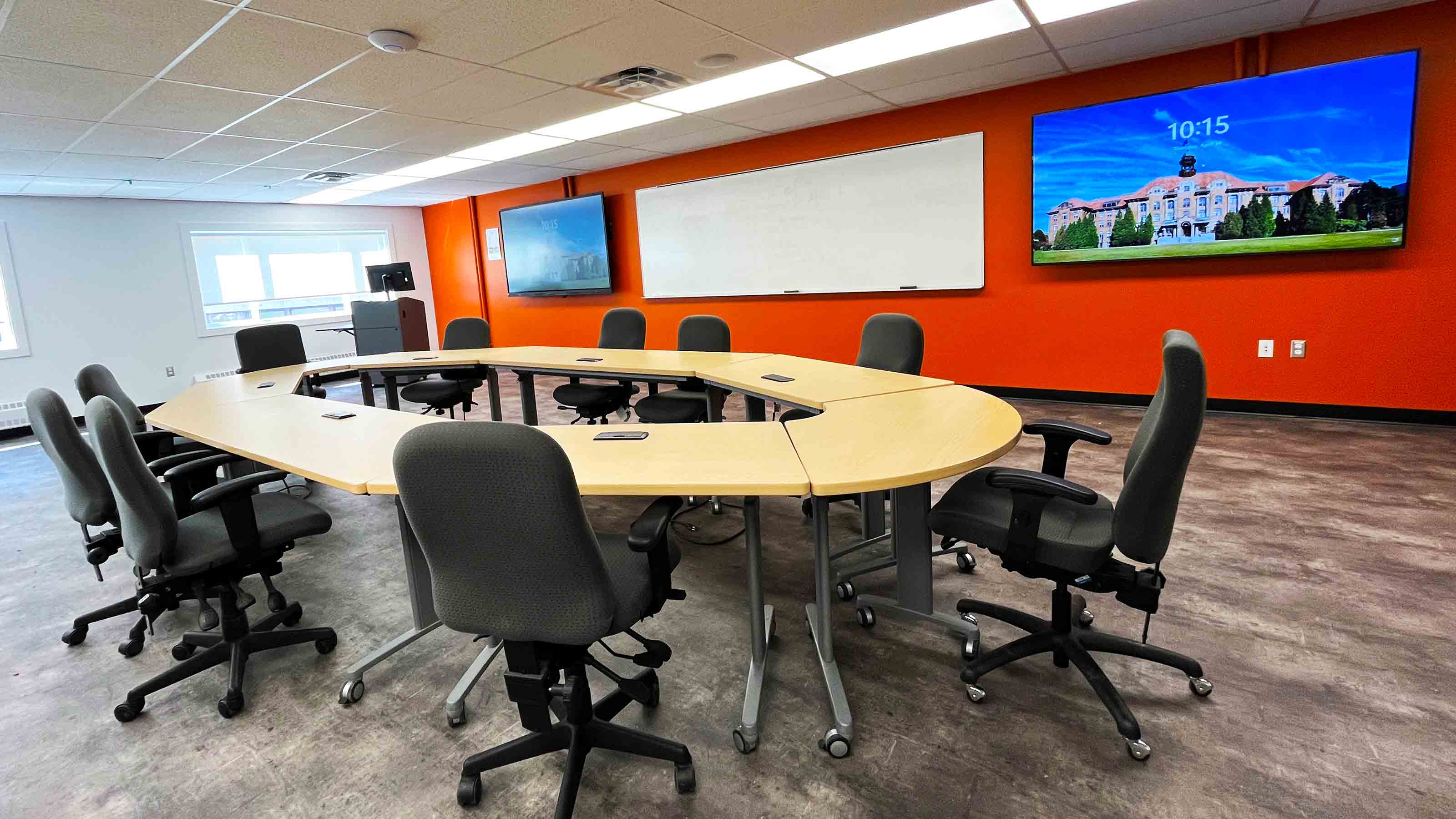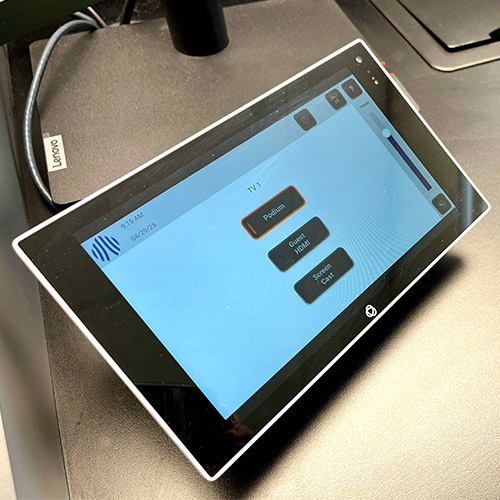Desperately needing to expand its classroom facilities but faced with little available space and aging infrastructure, John Abbott College, a relatively small, 8,000-student public general and professional institution in Montreal, Quebec, had to get creative. Instead of breaking ground on a new building, the school brought in 32 mobile home-sized modular units and connected them to create 13 new classrooms.
It’s a novel housing idea that’s sweeping across Canada and helped save time and money completing the new addition. The unique classrooms, each about 1,200 square feet in size, are now up and running at the school’s new Maple Hall building, where systems integrator AVI-SPL Canada (Quebec) leveraged a newly installed IP network to equip the classrooms with a variety of AV over IP technologies from Kramer AV.
Installing and testing all the AV equipment was completed in four months. Initial Cat 6 wiring started in September 2024, and students began using the new rooms in January.
“The extensive features of AV over IP make it easier to use and provide more value than traditional point-to-point setups,” said Marc Porlier, regional sales manager, Eastern Canada, at Kramer AV. “The technology enhances the learning experience by offering versatile and scalable AV solutions. AV over IP technology is straightforward to install, reducing setup time and complexity. Its flexible deployment options allow for seamless integration into various educational environments, accommodating different teaching styles and classroom configurations.”
Invisible to Learning
There’s now a new Kramer KT-208 8-inch control panel and a preview monitor at each teacher’s podium at the front of the room, driving an 86-inch SMART Technologies interactive screen and another 86-inch LG monitor. The smart display allows teachers to annotate, draw, and manipulate content in real time, making lessons more interactive and visually appealing. Students can also interact with the display, fostering a collaborative learning environment.
Signals are distributed over the IP network to enable different sources to be displayed both from the teacher’s laptop and other classrooms. While each classroom is operating as a separate identity at the moment, there have been some use cases of two rooms sharing resources simultaneously.

“The system handles a lot of the guesswork the teachers used to have to think about,” said Ryan Forster, coordinator, end user experiences at John Abbott College, who spearheaded the design and management of the classroom technology project. “So, we've simplified what they have to do to set up their lessons, but we're also trying something that's going to allow us to scale differently.
"We used to treat every classroom as an individual room, but now we've got the foundation for multi-screen environments. So, teachers can very easily split apart their activity. They can have this source on this screen for this group, and this source is on that screen for another group. The flexibility is really what attracted us to using IP.”
Kramer AV technology is not new to Forster, having worked with them on several projects at the college and nearly 100 traditional classrooms. They enjoy the simplicity of the technology for the end user and the ease of setting it all up.
“The exciting part is that video over IP will technically allow us to go from any encoder to any decoder on our campus, and we can realistically start to send content anywhere we need it to go very quickly and easily,” said Forster. “When we spoke to Kramer about the type of technology we wanted to use, we told them, ‘The best design for our purposes is almost no design.’ We want the technology to be very seamless for our teachers and not get in the way of their lessons.”
A key aspect of the new system is the implementation of comprehensive IP system control, which enables school administrators to quickly learn to seamlessly operate AV features, as well as room lighting and window shade positioning. For Forster, this allows them to make system adjustments without needing to call on the integrator for assistance. Plus, motion sensors automatically shut down the system when no movement is tracked for a given period, which results in significant energy savings.
“For us, this was a quick and easy install,” said Kevin McCoubrey, senior account manager at AVI-SPL. “The customer was prepared for us to come in, and the entire project was well planned from the beginning.”
New Yet Familiar

Most of the rooms at John Abbott College are traditional setups with a single podium and wall screen at the front, which McCoubrey called a "very closed" system. Now, they have a standard regular display for the content as well as an interactive display. Teachers can write annotations on their laptops that are seen on the larger display for the students. Plus, the Kramer control panel supports various multimedia formats, enabling teachers to incorporate videos, images, and other digital resources into their lessons.
A rack in each podium includes a small AV switch for video sources and audio levels. A Kramer AV audio amplifier powers everything. The college kept the familiar scenario of a podium with a laptop connection, but now there is much more flexibility thanks to the internal IP network.
Beyond the flexibility, officials also wanted something they could program on their own. Forster and the assigned IT project team worked with Kramer AV product engineers to create streamlined user interface software that runs on the Kramer tablet displays on the podiums, which teachers can operate without extensive training.
While there was a bit of coding software that was required, Forster said he didn’t want the teachers getting involved at that level. “I expect my teachers to come in and start their lesson right away,” he said. “For them, a minute lost or five minutes lost to technology is a problem. I don't want to have to get a call for a class in session and have to dispatch somebody and sort something out. So far, the systems have been very reliable and the teachers have taken to them quite easily."
Each room also has either six or eight Kramer Galil 6-C ceiling speakers. “We were a little concerned about the 8-foot height of the new rooms,” said McCoubrey, “but it all worked out fine.”
Another technology that’s used frequently is VIA GO, Kramer's device-agnostic streaming product, which is used by teachers and students for streaming up to 4K content from a phone, computer, or tablet to the big screens. The product gives iOS, Android, Chromebook, PC, and Mac users instant wireless connectivity with 4K advanced presentation capabilities.
“This is the type of device that I would see one per input so that I could have four or five student groups broken out and each working on their own screen,” Forster explained. “They can simply cast your content to the screens and they’re good to go. And then the teacher could remotely or from her panel share that with up to all five and say, ‘Guys, look at what Team One has done,’ and display that around the room.”
Networked Success
The AV over IP system at John Abbott College accommodates group-based work that doesn’t get in the way of teaching, which was the goal with the technology from the beginning. Plus, it supports the future expansion of AV options. For example, in the case of a class where a guest presenter attracts more attendees than the main classroom can accommodate, the system can easily connect additional rooms to handle the overflow.
With the initial success they’ve had, Forster said they will certainly add more networking to the college’s existing facilities soon. He sees it as the future of educational facilities around the world.
“I think there are two perspectives here on why an AVoIP infrastructure works so well for us, one from a pedagogical perspective and then one from the IT perspective,” he said. “The pedagogical perspective is looking for flexibility. And they want to expand and grow based on the needs that they have today, which might be different than yesterday or tomorrow. A classroom that was previously assigned to business students might be needed by the social scientists. Things can change rapidly, and the room needs to be able to accommodate those changes.
“From an IT perspective, if we don't have to pull everything else out and redesign from scratch, that's a win,” he continued. “So, by putting in a scalable system versus one that's point-to-point and does one job but really can't do anything else, that's an advantage from a resource perspective and a timing perspective. It offers a future-proof way to approach classroom spaces or teaching and learning spaces."

